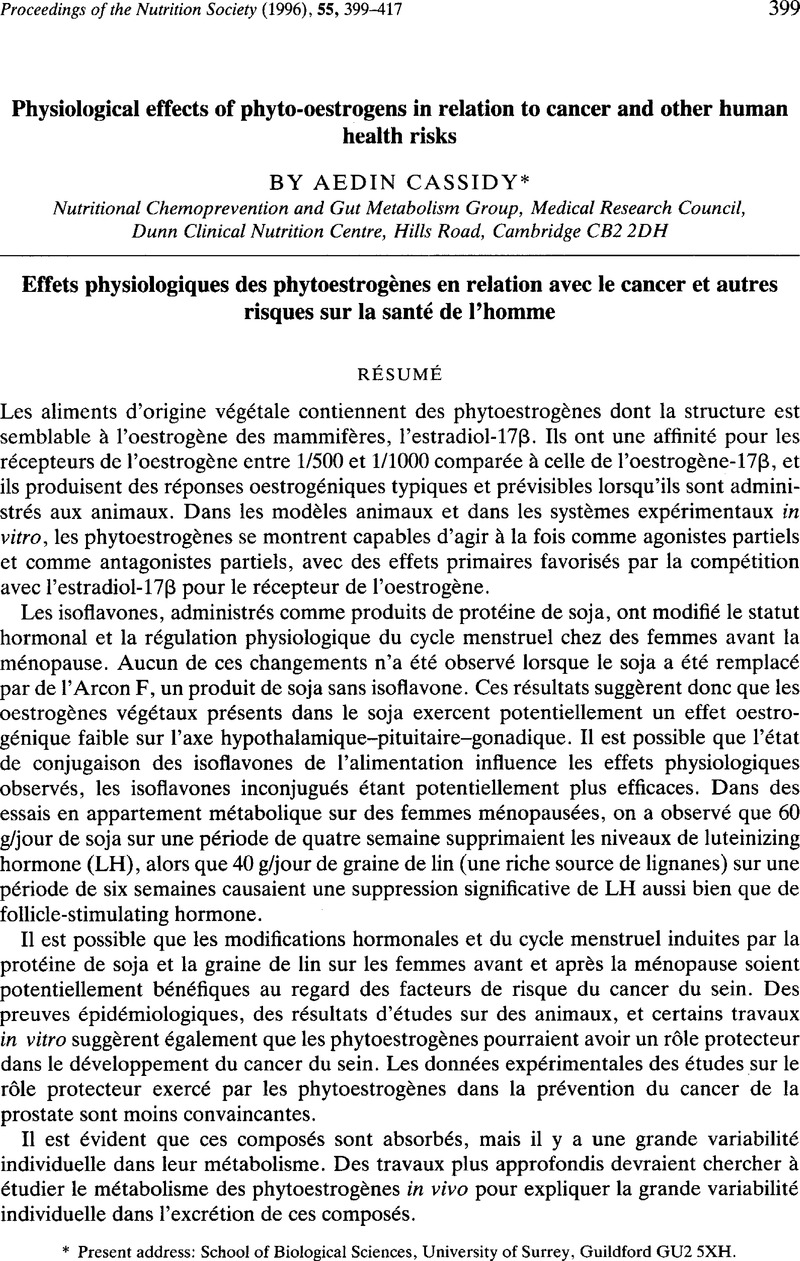Crossref Citations
This article has been cited by the following publications. This list is generated based on data provided by Crossref.
1996.
Clinical development plan: Genistein.
Journal of Cellular Biochemistry,
Vol. 63,
Issue. S26,
p.
114.
Wiseman, Helen
1997.
Dietary phytoestrogens: disease prevention versus potential hazards.
Nutrition & Food Science,
Vol. 97,
Issue. 1,
p.
32.
Cassidy, A.
and
Milligan, S.
1998.
How significant are environmental estrogens to women?.
Climacteric,
Vol. 1,
Issue. 3,
p.
229.
Müller, Severin
Schmid, Peter
and
Schlatter, Christian
1998.
Evaluation of the estrogenic potency of nonylphenol in non-occupationally exposed humans.
Environmental Toxicology and Pharmacology,
Vol. 6,
Issue. 1,
p.
27.
Müller, Severin
Schmid, Peter
and
Schlatter, Christian
1998.
Pharmacokinetic behavior of 4-nonylphenol in humans.
Environmental Toxicology and Pharmacology,
Vol. 5,
Issue. 4,
p.
257.
1998.
Proceedings of the British Toxicology Society Annual Congress University of Surrey, Guildford 19 - 22 April 1998.
Human & Experimental Toxicology,
Vol. 17,
Issue. 9,
p.
469.
Metzler, Manfred
and
Vieths, Stefan
1998.
Lebensmittelchemie.
Nachrichten aus Chemie, Technik und Laboratorium,
Vol. 46,
Issue. 3,
p.
319.
Millward, D. Joe
1999.
The nutritional value of plant-based diets in relation to human amino acid and protein requirements.
Proceedings of the Nutrition Society,
Vol. 58,
Issue. 2,
p.
249.
Meyer, H. H. D.
1999.
Estrogens and Antiestrogens II.
Vol. 135 / 2,
Issue. ,
p.
613.
Geissler, Catherine
1999.
China: the soyabean-pork dilemma.
Proceedings of the Nutrition Society,
Vol. 58,
Issue. 2,
p.
345.
Setchell, Kenneth D.R.
and
Cassidy, Aedin
1999.
Dietary Isoflavones: Biological Effects and Relevance to Human Health.
The Journal of Nutrition,
Vol. 129,
Issue. 3,
p.
758S.
Wiseman, Helen
1999.
The bioavailability of non-nutrient plant factors: dietary flavonoids and phyto-oestrogens.
Proceedings of the Nutrition Society,
Vol. 58,
Issue. 1,
p.
139.
Cassidy, Aedin
1999.
Potential tissue selectivity of dietary phytoestrogens and estrogens.
Current Opinion in Lipidology,
Vol. 10,
Issue. 1,
p.
47.
Coldham, Nick G
Howells, Laurence C
Santi, Annalisa
Montesissa, Clara
Langlais, Claudia
King, Laurence J
Macpherson, David D
and
Sauer, Maurice J
1999.
Biotransformation of genistein in the rat: elucidation of metabolite structure by product ion mass fragmentologyn.
The Journal of Steroid Biochemistry and Molecular Biology,
Vol. 70,
Issue. 4-6,
p.
169.
Mauri, Pierluigi
and
Pietta, Piergiorgio
2000.
Electrospray characterization of selected medicinal plant extracts.
Journal of Pharmaceutical and Biomedical Analysis,
Vol. 23,
Issue. 1,
p.
61.
Rossmanith, W. G.
Degen, G. H.
Leyendecker, G.
Kunz, G.
Noe, M.
Herbertz, M.
Beil, D.
Mall, G.
Schulze, W.
Knuth, U. A.
Fischer, R.
Naether, O. G. J.
Rudolf, K.
Baukloh, V.
Würfel, W.
Diedrich, K.
Felberbaum, R.
Ludwig, M.
and
Ortmann, O.
2000.
52. Kongreß der Deutschen Gesellschaft für Gynäkologie und Geburtshilfe.
p.
437.
Bolt, Hermann M.
and
Degen, Gisela H.
2000.
Hormoneffekte von Chemikalien in Nahrung und Umwelt.
Chemie in unserer Zeit,
Vol. 34,
Issue. 1,
p.
30.
Wiseman, Helen
O’Reilly, James D
Adlercreutz, Herman
Mallet, Anthony I
Bowey, Elizabeth A
Rowland, Ian R
and
Sanders, Thomas AB
2000.
Isoflavone phytoestrogens consumed in soy decrease F2-isoprostane concentrations and increase resistance of low-density lipoprotein to oxidation in humans.
The American Journal of Clinical Nutrition,
Vol. 72,
Issue. 2,
p.
395.
Lawrence, Julia A.
Malpas, Phyllis B.
Sigman, Caroline C.
and
Kelloff, Gary J.
2000.
Clinical development of estrogen modulators for breast cancer chemoprevention in premenopausal vs. postmenopausal women.
Journal of Cellular Biochemistry,
Vol. 77,
Issue. S34,
p.
103.
Nielsen, Salka E.
Freese, Riitta
Cornett, Claus
and
Dragsted, Lars O.
2000.
Identification and Quantification of Flavonoids in Human Urine Samples by Column-Switching Liquid Chromatography Coupled to Atmospheric Pressure Chemical Ionization Mass Spectrometry.
Analytical Chemistry,
Vol. 72,
Issue. 7,
p.
1503.



